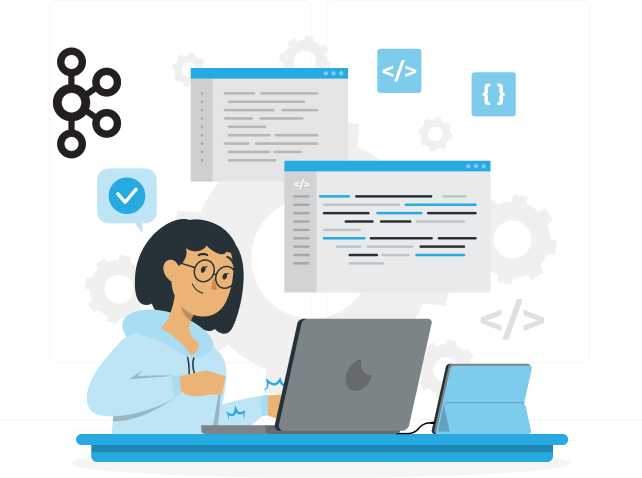In an ever-evolving data-driven world, today, businesses are constantly seeking opportunities to tap into their resources with data to make informed decisions. While proprietary business intelligence tools are the most-used and recommended solutions, open source BI applications have been gaining popularity because of their affordability and flexibility.
These tools give companies all the power of data visualization, analysis, and reporting, all for a fraction of what is spent on commercial solutions. This article outlines 15 free and open-source BI tools poised to change the world of business intelligence.
15 Open Source BI Tools to Reshape the Future:
1. Metabase: A Simple, Intuitive Open Source BI Tool
Metabase is arguably one of the most popular, free-of-cost, open-source BI tools in the market today. It enjoys widespread popularity as its interactive dashboards with easy interface enable non-technical end-users to generate a set of extensive reports. Excellent for the small and mid-sized enterprises to churn out insights at an exponential pace from its data stores without requiring a single data analyst within the house.
With regard to cloud-based reporting tools and databases, Metabase can easily integrate with a wide number of them, which is highly convenient for businesses that must utilize external systems to collect and store data.
Use Case:
Metabase was used by an evolving e-commerce platform to analyze performance sales across multiple regions. With drag-and-drop simplicity, the marketing department could create real-time dashboards, monitor promotional campaigns and monitor sales strategies.
2. BIRT (Business Intelligence and Reporting Tools)
BIRT is a powerful open-source platform enabling developers to create compelling reports and dashboards. It is widely used for integrating reports into web-based applications, allowing access to critical business information at any time. BIRT excels in creating highly customizable reports, including complex and multi-layered data visualizations.
BIRT vs Power BI:
Power BI is famous for its robust feature set and ease of use, but BIRT stands out with its ability to provide very customizable reporting solutions for developers that require deep integration into their existing applications. For business users who need detailed reporting and have specific design requirements, BIRT is a good choice.
Use Case:
The large healthcare provider utilized BIRT in building detailed patient care reports, which were embedded into internal applications to provide doctors and nurses with updated insights about their patients’ conditions and ensure better care.
3. Apache Superset: Cloud-Based Scalable BI Tool
Apache Superset is an open-source BI platform. It is scalable, user-friendly, and capable of handling large datasets. Apache Superset stands out with its beautiful visualizations and dashboards. The reporting tools in Apache Superset are highly adaptable for any organization requiring flexible BI solutions in a cloud-first environment.
Use Case:
A telecommunications firm used Apache Superset to plot complex data about its customers, which included churn rates and service use patterns. The large data handling along with customisable visualisations on the platform helped improve customer retention decisions for this company.
4. KNIME: Open Source Data Analytics and Reporting Tool
KNIME is the powerful open-source data analytics platform supporting data mining, predictive analytics, and machine learning. Using KNIME, users build complex data workflows and have integration with the popular tools like R and Python, making it an excellent alternative when businesses need to go further beyond traditional BI into advanced analytics.
KNIME vs Power BI:
Power BI is all about the simple approach to ease usage, KNIME is built to help deliver advanced analytics. It will be preferred when looking to obtain a powerful code-free solution to create predictive models as well as advance analytics workflow.
Use Case:
Logistics company used KNIME to develop predictive models that forecast delivery times given historical data. This way, they enhanced their operational efficiency and better served the needs of customers more consistently.
5. Pentaho: Full-featured Open-Source BI Platform
Pentaho is an open-source business intelligence platform that offers data integration, reporting, dashboards, and data mining. Its capacity to handle large datasets with robust integration features makes it suitable for organizations of any size. Pentaho is very useful to businesses that need to combine data from different sources into a unified view for decision-making.
Use Case:
The retail chain used Pentaho’s integration and visualization capabilities with data integration to combine sales data between physical and online channels, enabling it to find out trends between all channels for inventory and marketing.
6. SpagoBI: The Open Source BI Suite for Advanced Analytics
SpagoBI is the full-suite free and open source business intelligence tool, which includes reporting features, dashboards, data mining, and OLAP. The power of customization makes it highly extendable toward any flexibility requirement that businesses may face in their BI solutions.
Use Case:
A manufacturer used SpagoBI to analyze its production data from various plants. By visualizing this, they were able to note inefficiencies and make some data-driven decisions that led them to reduce their operational costs by about 10%.
7. ReportServer: Reporting Tool of Business Intelligence
ReportServer is an open-source reporting platform that supports a wide range of reporting formats and integrates with both relational and NoSQL databases. It’s especially valuable for businesses needing customizable reporting solutions that can scale with their needs.
Use Case:
This global logistics company used ReportServer to simplify reporting across a variety of locations. Having reports customized for each department allowed them to cut the report generation time by 30%.
8. ClicData: The Free Reporting Software Solution
ClicData is a self-service analytics business intelligence tool, intuitive and open source. It offers cloud-based reporting capabilities, allowing users to produce reports and dashboards in real-time. It’s great for businesses that want to provide the ability for users to build their own reports.
Use Case:
The company used ClicData to provide their customers access to customizable dashboards so the customers could track key metrics related to subscription renewals, for example, and user engagement-to allow them to optimize themselves for using the software more efficiently.
9. Dash by Plotly: An Open Source alternative to Tableau
Dash by Plotly is an open-source framework for creating analytical web applications in Python. It is best suited for data scientists who want to develop interactive, web-based dashboards. Dash is considered to be one of the most flexible and is regarded as a solid open-source alternative to Tableau.
Use Case:
Dash is used to develop interactive tools for data visualization by a research institute in order to make available scientific research findings to scientists. This allows them to easily collaborate and make decisions using data visualization.
10. Sisense: Self-Service BI Tool
Sisense is a powerful, open-source BI tool focusing on the delivery of self-service analytics. It is an interactive reporting and dashboard tool where users can create without having to rely on IT support. This is meant for organizations wishing to empower employees across different departments to make data-driven decisions.
Use Case:
A retail firm deployed Sisense self-service BI tools to give regional managers complete access to performance data relating to their stores. With real-time insights, the managers could quickly adapt strategies, leading to increased sales.

Source: PAT Research
11. Jet Reports: Open Source Reporting for ERP Systems
Jet Reports is an open-source reporting tool for businesses that operate on ERP systems, like Microsoft Dynamics. It can be used to create any custom report directly from the ERP systems. This makes it the best tool for companies looking to take advantage of ERP data in making better decisions.
Use Case:
An enterprise manufacturer integrated Jet Reports with the company’s ERP system in order to track production efficiency and inventory levels. They were thus able to learn valuable lessons from their supply chain that helped cut production delays by 20%.
12. iReport: Open Source Competitive Intelligence Tool
iReport is an open-source business intelligence tool with a specialty in producing customized reports and visualizations; it has excellent integration with other BI platforms, making it suitable for conducting competitive intelligence analysis.
Use Case:
A consulting firm created market research reports in iReport, which helped clients find competitive opportunities. These reports made fast and effective production possible by offering valuable information that can help clients move ahead of their competitors.
13. Google Data Studio: A Self-Service BI Tool
Google Data Studio is a free tool by Google that empowers users to build custom interactive dashboards and reports, using data from Google Analytics, Google Ads, and much more. It’s a great fit for businesses that want a pretty straightforward self-service BI solution.
Use Case:
A digital marketing agency used Google Data Studio to create real-time dashboards for their clients. This would enable clients to monitor the performance of their campaign and then make on-the-fly changes to the campaign to improve its ROI.
14. Orange: Open-Source Data Analytics and Machine Learning
Orange is an open source data analysis and visualization program that supports machine learning and data mining. It is compatible with both data scientists as well as non-technical individuals, making it a versatile option in many business applications.
Use Case:
A nonprofit organization uses Orange to analyze donor behaviors and find out key observations about donation patterns. The same insights were used by them to optimize their fundraising policies, which resulted in raising donations by 25 percent.
15. MySQL Workbench: Open Source reporting on MySQL Databases
MySQL Workbench is open-source management and reporting on your MySQL databases. That could be great for any businesses relying on MySQL databases that require reporting directly on custom reports from their own database.
Use Case:
A tech startup used MySQL Workbench to generate detailed sales reports from their MySQL database. These showed them who were the most successful sales teams and which products were more successful than others, helping them apply tighter marketing efforts.
Conclusion
The free open-source BI tools are changing the way businesses look at data analysis, reporting, and decision-making. Such open-source tools offer flexibility in the solution to customize it as needed, integrate with existing systems, and scale according to the needs of the business.
Whether you’re looking for cloud-based reporting tools, competitive intelligence software, or advanced data analysis features, these 15 open-source BI tools are all solid contenders for future-proofing your organization’s BI strategy. Start exploring these tools today, and watch your business’s data-driven decision-making soar.
If you are a business looking to get started with Business Intelligence or other tech solutions, we are here to help you! You can get in touch with us!

Start a Project with Ajackus



































































































































































